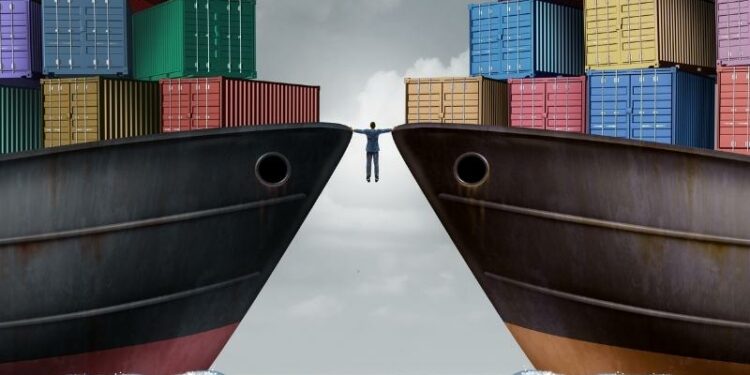International trade is documented as far back as the 19th century BC. Trading local items with foreigners took on a new significance with the formation of nation-states and the fight for resources. It became a weapon to raise national wealth and influence other countries. Thus, the efficacy of a country’s international trade strategy, assessed by the balance between export and import operations values, determines its economic strength and growth potential. A country’s currency is affected by this; thus, forex traders matter.
What is the balance of trade (BOT)?
The BoT is the difference between a country’s total value of exports and imports over a given period. In the specified time, the BoT reveals whether the country could sell locally produced goods and services to foreign countries more than it imported things from other countries. As a result, the BoT is regarded as the primary economic indicator of a country’s foreign trade activity and an essential metric for measuring economic growth.
The BOT is positive when the entire value of exports exceeds the total value of imports, resulting in a trade surplus. It is negative when the total value of exports is less than imports, resulting in a trade deficit. A trade deficit occurs when a country spends more than it earns in international markets. As a result, the government may be obliged to impose new taxes or borrow money from other nations or international financial institutions such as the International Monetary Fund to make up for the budget deficit.
The BoT is the most significant component of the Balance of Payments (BOP), a record of a country’s foreign financial transactions. The sum of all inbound and outbound transactions between a country’s economic entities and the rest of the world is the BOP. Two accounts should theoretically balance each other, resulting in a zero-sum BoP. Different economic policies and swings in foreign exchange prices, on the other hand, frequently produce variances.
What are the components of BOT?
Current account
This account is used to track the flow of products in and out of countries. The account is used to record all export and import items, including raw materials and produced goods, and their receipts and payments.
Capital account
This account tracks international financial activities. It covers the acquisition and disposition of assets and the flow of taxes. Finance in the current account is used to control the capital account excess.
Financial account
This account is necessary to assess local and foreign ownership changes of domestic assets. When foreign ownership exceeds domestic ownership, the financial account is in deficit. As a result, evaluating and comprehending financial account changes permits assessing whether a government is selling or purchasing additional assets.
Calculation
Formula
X – M = BoT
where:
X = Exports
M = Imports
Example
In January 2021, the UK imported £35.5 billion in goods. The country exported goods worth £21.2 billion to foreign countries.
Thus, BoT= X-M
£21.2 billion- £35.5 billion= -£14.3 billion.
So, in January, the UK had a BoT of -£14.3 billion, or a £14.3 billion trade deficit
The calculation may change depending on the country. The principal BoT report in the Eurozone and France, for example, solely accounts for products and excludes services. The BoT of services in France is computed independently, with two categories aggregated in a separate report.
Why does BoT matter in forex trading?
The BOT shows if a country is producing additional resources beyond its capacity to make value locally. Governments and central banks regularly follow the BoT numbers to adapt their policies as a primary indication of economic growth potential and an integral portion of the Gross Domestic Product (GDP). How does this affect forex trading?
GDP reading that is lower than expected
Traders are more likely to observe a sell-off of that particular local currency in respect to other currencies if the GDP number is lower than predicted. Lower GDP rates indicate an economic downturn, reducing the likelihood of an increase in interest rates, thus lowering the attractiveness or overall worth of the currency. The more GDP data falls short of expectations, the more the legal tender falls.
Expected GDP figure
GDP data in line with expectations need a little extra attention from the forex trader. The trader will want to compare the current number to the prior quarter’s or year’s data to understand the currency’s economic status better. As a result, the price movement will likely be mixed, as the market takes time to figure through the situation and the report’s specifics.
GDP reading that is higher than expected
Higher-than-expected GDP figures will almost certainly boost the currency concerning other currencies. A greater US GDP rate, for example, will benefit the dollar, causing it to grow in value against other currencies. The greater the increase in a country’s GDP, the greater the increase in the country’s currency value.
Factors that affect BoT
- Major domestic industries and their internal dynamics, such as supply and demand in the local market
- International relations with significant trading partners
- Raw material and intermediate goods costs
- Custom controls
- Trade policies, taxes, regulations, and restriction
- The exchange rate variations
Conclusion
The difference in the monetary value of exports and imports of a country’s economic production over a given period is known as the BOT—one of several economic elements that influence a country’s currency’s relative worth. BOT has an impact on GDP, which is essential to FX traders. FX traders should keep an eye on the BOT of the currencies they are dealing with to make informed decisions.




